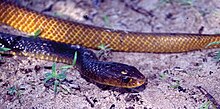You can help expand this article with text translated from the corresponding article in Portuguese. (July 2021) Click for important translation instructions.
|
| Indigo snake | |
|---|---|

| |
| Conservation status | |
 Least Concern (IUCN 3.1) | |
| Scientific classification | |
| Domain: | Eukaryota |
| Kingdom: | Animalia |
| Phylum: | Chordata |
| Class: | Reptilia |
| Order: | Squamata |
| Suborder: | Serpentes |
| Family: | Colubridae |
| Genus: | Drymarchon |
| Species: | D. corais |
| Binomial name | |
| Drymarchon corais (Boie, 1827) | |
| Synonyms | |
| |
The indigo snake (Drymarchon corais), also known as the yellow-tail cribo, is a species of snake in the family Colubridae. This large colubrid snake is nonvenomous.
Taxonomy
Until recently, all Drymarchon were classified as subspecies of D. corais. However, North and Central populations are now assigned to different species (D. melanurus, D. couperi and D. kolpobasileus), and D. caudomaculatus and D. margaritae are recognised as separate species in South America.
Range

This snake is found in South America, including Bolivia, Brazil, Colombia, Ecuador, French Guiana, Guyana, Paraguay, Peru, Suriname and Venezuela as well as Trinidad and Tobago.
Diet
The species forages on the ground, sometimes climbing low vegetation. It feeds on a variety of prey species including fish, frogs, reptiles, reptile eggs, mammals, birds and bird eggs.
Gallery
References
- ^ Ines Hladki, A.; Ramírez Pinilla, M.; Renjifo, J.; Urbina, N.; Nogueira, C.; Gonzales, L.; Catenazzi, A.; Cisneros-Heredia, D.F.; Hoogmoed, M.; Schargel, W.; Rivas, G.; Murphy, J. (2019). "Drymarchon corais". IUCN Red List of Threatened Species. 2019: e.T62234A3110201. doi:10.2305/IUCN.UK.2019-3.RLTS.T62234A3110201.en. Retrieved 20 November 2021.
- "Drymarchon corais (Boie, 1827)". Catalogue of Life. Species 2000: Leiden, the Netherlands. Retrieved 21 July 2023.
- "Drymarchon corais". The Reptile Database. Retrieved 2023-07-21.
- "Drymarchon". Integrated Taxonomic Information System. Retrieved 2011-02-06.
- "Drymarchon corais (Yellow-tailed Cribo or Indigo Snake)" (PDF). The Online Guide to the Animals of Trinidad and Tobago.
- Species Drymarchon corais at The Reptile Database
| Taxon identifiers | |
|---|---|
| Drymarchon corais | |
| Coluber corais | |
- IUCN Red List least concern species
- Reptiles described in 1827
- Drymarchon
- Reptiles of Bolivia
- Snakes of Brazil
- Reptiles of Colombia
- Reptiles of Ecuador
- Reptiles of French Guiana
- Reptiles of Guyana
- Reptiles of Paraguay
- Reptiles of Peru
- Reptiles of Suriname
- Reptiles of Trinidad and Tobago
- Reptiles of Venezuela
- Taxa named by Friedrich Boie



